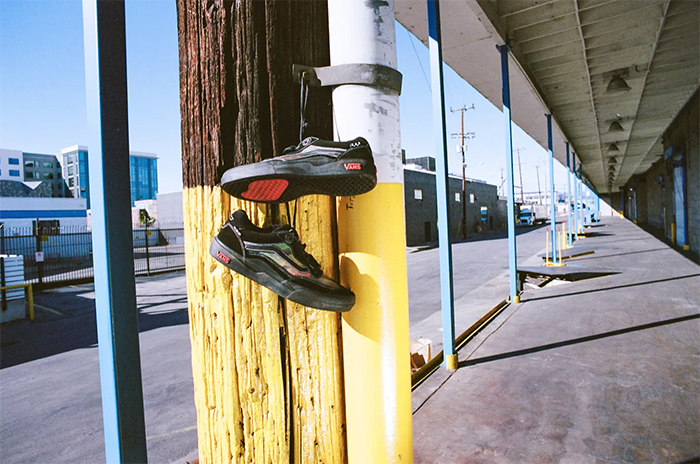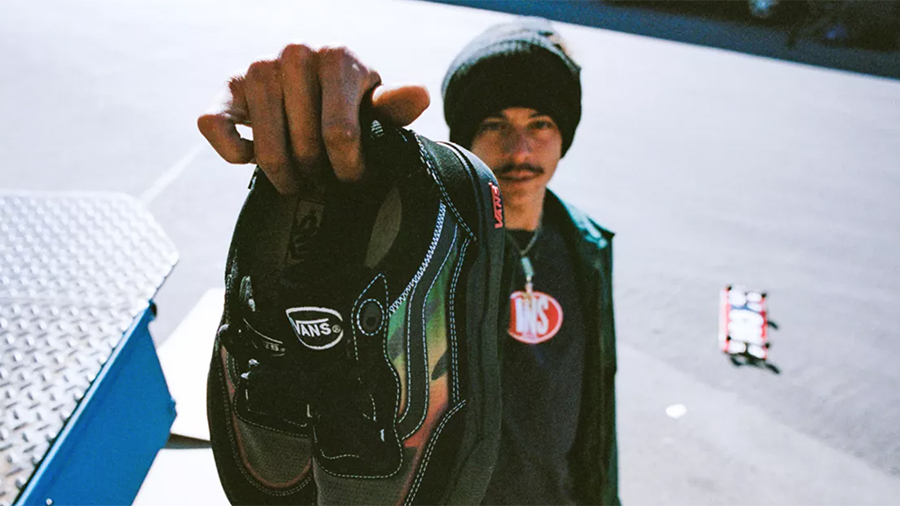VF Corp. raised its outlook for its fiscal year after reporting results in the first quarter ended June 30 came in well ahead of expectations, helped by signs of recovery at Vans and continued strength in digital. The outlook reflects stronger-than-expected order books for its four primary brands, which also include The North Face, Timberland and Dickies, and strength at two emerging brands, Altra and Smartwool.
“We’re encouraged by the strong start to our fiscal 2022 year,” said Steve Rendle, VF’s chairman, president and CEO, on a call with analysts. “Our teams delivered an outstanding first quarter, powering VF back to pre-pandemic revenue levels while driving an earnings recovery well ahead of our initial expectations. We continue to see broad-based momentum across the portfolio, which furthers my confidence in our ability to accelerate growth through fiscal 2022 and beyond.”
Rendle noted that the near-term environment remains “somewhat clouded” by virus surges in Southeast Asia, uncertainties in other regions brought on by the impact of new variants and further pressures on the global supply chain. He added, “Our teams are executing. We remain focused on the things that we can control and winning in the parts of our business where the consumer is coming back strong. And we remain confident in our ability to continue driving this sharp recovery across our business.”
First-Quarter Revenues Climb 104 Percent
In the first quarter, revenues catapulted 103.9 percent to $2.2 billion and increased 96 percent in constant dollars. Excluding acquisitions, organic revenue increased 90 percent on a reported basis and 83 percent in constant dollars. Wall Street’s consensus estimate had been $2.14 billion.
The first quarter is the smallest quarter for VF, but sales reached pre-pandemic levels one quarter ahead of initial expectations. Momentum was seen across brands, regions and channels.
By channel, its global DTC business delivered high-single-digit growth relative to prior peak levels, driven by a strong acceleration from VF’s brick and mortar stores in the U.S and continued strength in digital.
VF’s organic DTC digital businesses are now 72 percent above fiscal 2020 levels, representing a 31 percent two-year CAGR growth. Strength is also being seen at key digital partners globally with pure-play digital wholesale growth of over 70 percent relative to fiscal 2020. Total digital penetration was roughly a quarter of Q1 revenues, which represents about double the penetration from the first quarter of 2020.
The wholesale business grew over 100 percent organically in Q1, approaching prior peak fiscal 2020 levels. Rendle said, “Strong sell-through trends and clean inventory levels from the past year are now translating into stronger fall 21 and spring 22 order books, supporting an improving outlook for our wholesale business for this year and beyond.”
By segment, Active revenue increased 128 percent (up 120 percent in constant dollars), including a 110 percent (102 percent in constant dollars) increase in Vans brand revenue and a 26 percentage point revenue growth contribution from acquisitions.
Outdoor segment revenue increased 81 percent (up 72 percent in constant dollars), including a 93 percent (83 percent in constant dollars) increase in The North Face brand revenue.
Work segment revenue increased 69 percent (up 66 percent in constant dollars), including a 61 percent (58 percent in constant dollars) increase in Dickies brand revenue.

Vans Returns To Pre-Pandemic Growth
Vans returned to pre-pandemic revenue levels, growing 102 percent in Q1 on a currency-neutral basis. The growth was led by the Americas, up 144 percent on a currency-neutral basis, followed by EMEA, ahead 125 percent and APAC, up 19 percent.
“The recovery has been led by global DTC business which drove double-digit growth relative to fiscal 2020, led by 73 percent growth in digital,” said Rendle.
Vans DTC strength has been broad-based with each region recording positive DTC growth relative to pre-pandemic levels. Vans’ store growth has seen traffic return sooner than expected with encouraging trends in DTC KPIs, including consumers buying more frequently and spending more per purchase relative to historic levels.
In the EMEA, the 125 percent growth benefited from strength across all major markets as stores reopened throughout the region. Vans’ EMEA business is up 30 percent relative to fiscal 2020.
APAC’s 19 percent growth for Vans was led by 22 percent growth in China. A soft launch of the Vans Family loyalty program was launched in China in June and over 1 million new loyalty members were added following the launch, bringing membership to nearly 17 million.
“Vans kicked off its 52-week drop calendar this quarter, seeking to create a consistent, predictable globally aligned and focused approach to drive brand energy and consumer engagement,” said Rendle. “Seven weeks into the program, we are encouraged by the initial consumer reads and the instant sell-outs of several early drops.”
Vans will more formally market the Vans’ droplist in fiscal Q3 ahead of the fall holiday season.
“We remain bullish on the setup for Vans moving through fiscal 2022 and are encouraged by the early reads from the back-to-school season underway,” said Rendle. Vans is now expected to grow 28 to 29 percent in fiscal 2022, representing growth of nine to 10 percent relative to fiscal 2020. Previously, VF predicted Vans would see 26 percent and 28 percent growth, representing a 7 percent to 9 percent increase relative to prior peak revenue.

The North Face Surges 83 Percent
The North Face’s global revenues gained 83 percent, representing 6 percent growth above pre-pandemic levels. All regions rebounded sharply in Q1, highlighted by “continued exceptional” performance in EMEA, which grew 142 percent versus the prior year and was up 58 percent to fiscal 2020. Year-over-year sales on a currency-neutral basis were up 80 percent in the Americas. The APAC region grew 22 percent, highlighted by 80 percent growth in digital relative to fiscal 2020 levels.
“The North Face’s spring sell-through rates were some of the highest in years, reflecting strong progress on the brand’s ability to drive 365-day relevancy,” said Rendle. “TNF continues to drive energy in On-Mounting categories with a Futurelight franchise, as well as the new Vectiv footwear rollout further establishing its legitimacy in outdoor footwear.”
TNF is also seeing outsized growth from the casual categories such as logo wear, which grew over 100 percent in Q1, as consumers show strong engagement with the brand Off-Mountain. TNF’s loyalty program, The Explore Pass, has grown to over 7 million consumers adding nearly 300,000 new members in Q1.
“We continue to be encouraged by the broad-based, global momentum in The North Face, and now expect the brand to deliver 26 to 27 percent growth this year, representing 15 to 17 percent growth relative to fiscal 2020,” said Rendle. Previously, The North Face was expected to increase between 25 percent and 27 percent, representing 14 percent to 16 percent growth relative to fiscal 2020.
TNF is also seeing strong improvements in profitability and the brand is expected to show mid-teen profitability in fiscal 2022.

Timberland Expands 63 Percent In Q1
Timberland delivered at 63 percent currency-neutral growth in Q1, tracking ahead of plan. The gains were led by the Americas, up 108 percent; followed by EMEA, ahead 58 percent. APAC was down 22 percent.
Said Rendle, “We’re encouraged by high-teens growth in the Americas and 87 percent growth in digital relative to fiscal 2020 levels.”
Timberland continues to see outsized growth from outdoor, apparel and Timberland PRO, each growing over 75 percent in the quarter. The momentum behind Timberland’s core iconic product also continues with heritage sales being strong demand despite historically low inventories.
Timberland also launched a Take Back program in partnership with Circled to enable consumers to return Timberland products to a brand store to be refurbished for resale or recycled into future products. The program aligns with the brand’s vision announced last fall for products to have a net positive impact on nature by 2030.
Due to the brand’s strong start, Timberland is now expected to deliver modest growth in fiscal 2022 relative to fiscal 2020, passing pre-pandemic revenues beginning with Q2. Previously, VF said it expected Timberland to increase between 16 percent and 18 percent, which implied revenue in line with prior peak levels.
Dickies Climbs 58 Percent
Dickies grew 58 percent on a constant-currency basis in the first quarter, well ahead of plan as the brand kicked off several new campaigns and inventories became more available.
“We’ve been pleasantly surprised by the intensity of sell-through performance across all wholesale partners in the U.S.,” said Rendle. “This acceleration continues to be driven by both work-inspired lifestyle products, which reported strong growth across all three regions, as well as core work items.”
Work-inspired lifestyle now represents about 40 percent of Dickies’ global brand revenue. The Dickies brand has also begun to deliver “meaningful profitability improvements,” driven by both gross margin expansion and SGMA efficiencies.
Said Rendle, “Q1 represented a strong start to our goal of returning to double-digit profit margins in the work segment in fiscal 2022.”
Following a strong Q1 performance and accelerating demand signals across channels, Dickies is now expected to expand mid-teens year-over-year in fiscal 2022, representing over 25 percent growth relative to fiscal 2020 levels. Previously, Dickies growth was expected between 10 percent and 12 percent against fiscal 2021 and up about 20 percent from fiscal 2020.
Net Earnings Double Internal Plan
Net earnings in the first quarter came to $324.2 million, or 82 cents a share, against a loss of $285.6 million, or 73 cents, a year ago. EPS from continuing operations, which excludes the exited occupational workwear business, came 39 cents per share against a loss of 71 cents a year ago.
Adjusted EPS from continuing operations increased 148 percent (up 144 percent in constant dollars) to 27 cents, including a 7 cents per share contribution from acquisitions. Adjusted results topped Wall Street’s consensus estimate of 11 cents and essentially doubled VF’s internal targets.
Gross margins recovered, expanding 260 basis points to 56.7 percent in Q1. Organic gross margin expanded relative to prior peak fiscal 2020 levels despite a 30 basis point headwind from a more challenging logistics and freight environment.
Operating income from continuing operations on an adjusted basis, increased 164 percent (160 percent in constant dollars) to $148 million, including a $32 million contribution from acquisitions.
VF’s updated full-year outlook includes:
- Revenue is now expected to be at least $12.0 billion, reflecting growth of at least 30 percent, including an approximate $600 million contribution from the Supreme brand. This compares to the previous expectation of approximately $11.8 billion, reflecting growth of approximately 28 percent. The stronger outlook is supported by stronger-than-anticipated order books for its four primary brands, Vans, The North Face, Timberland, and Dickies, “sizeable increases” at Altra and Smartwool, and accelerating DTC trends observed over the past five months.
- By segment, revenue for Outdoor is now expected to increase between 24 percent and 26 percent versus the previous expectation of a 23 percent to 25 percent increase; revenue for Active is now expected to increase between 37 percent and 39 percent versus the previous expectation of a 34 percent to 36 percent increase; revenue for Work is now expected to increase between 16 percent and 18 percent versus the previous expectation of a 10 percent to 12 percent increase.
- International revenue is expected to increase between 25 percent and 27 percent. By geographic region, in the EMEA region, revenue is expected to increase between 29 percent and 31 percent. In the Asia Pacific region, revenue is expected to increase between 18 percent and 20 percent. And, in the Americas (non-U.S.), revenue is expected to increase between 28 percent and 30 percent.
- DTC revenue is now expected to increase between 39 percent and 41 percent versus the previous expectation of 38 percent and 40 percent, including Digital revenue growth of between 29 percent and 31 percent.
- Adjusted gross margin is expected to exceed 56.0 percent, which represents an estimated increase of more than 270 basis points.
- Adjusted operating margin is now expected to increase more than 500 basis points to more than 13.0 percent, versus the previous expectation of approximately 12.8 percent.
- Adjusted EPS is expected to be at least $3.20, including an approximate 25 cent contribution from the Supreme brand. This compares to the previous expectation of approximately $3.05.
Photos courtesy Vans, The North Face, Timerberland
















